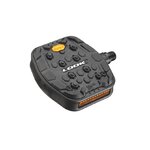If that biggot comment is directed at me, then sharpen up you comprehension skills.! Show me where I'm advocating not wearing a helmet.
I'm using decades of scientific data from one of the first countries to legislate compulsory helmet use, and I'm trying to demonstrate a well documented phenomena in how others react to the perceived level of protection a rider is wearing. This is to point out it might be worth wearing clothing over knee and elbow guards IF Wes still feels the need to invest in them.
Rather than advocating NOT wearing a lid, I've questioned if I should be wearing full face - and until the data is clear, I'm accepting motorbike urban data that clearly shows other road users take more risks towards full face vs open face riders. NB, I wear full face on my motorbike because it has the performance to escape from other road users. I've put more thought and research into this than you can possibly imagine, including long discussions with a research professor of psychology who specializes in driver behavior.
edit, correction, he rides a giant.
In my reading of your comments, I didn't think that you were
explicitly advocating against helmet use, but my overall impression was that you
were at least a little skeptical about their value. I believe that your comments could be interpreted, possibly misinterpreted, by someone that helmets are of marginal value. My concern was and is that those comments and the "research" could easily allow someone who would rather not wear one to justify that behavior. Here's what you said:
There is a lot of data on this phenomena, but one of the most interesting was a study measuring driver reaction to cyclists wearing helmets vs those without helmets. The drivers left more room for the riders without lids - presumably because they decided helmets provided some magical protection for the rest of the body when 2 tonnes of badly controlled metal goes wrong?
IN Australia, we've had compulsorily BICYCLE helmets since the 1970's , there's some really interesting data showing increased bicycle accident and mortality rates immediately following helmets becoming compulsory. (ie people perceiving less danger so taking extra risk - nb it was mostly cars hitting kids- NOT kids crashing by themselves )
We have publicly funded programs analyzing road trauma data , and there are boffins paid to crunch numbers on historical figures to try and justify their bosses existence...... but in recent years it's been interesting to see a move towards the psychology behind it all. Hence the study measuring how close vehicles pass cyclists with / without helmets
Here is the problem with the "research" you cited and the reason I put it in quotes. Nothing I read in your comments mentioned the
actual probability of injury or death with and without a helmet in those situations (roads and streets with cars) where the "helmet phenomenon" might cause some car drivers to be less careful. In my opinion, research that merely finds that drivers
think differently about bikers who wear helmets is of little or no use in assessing the value of helmet wearing. Even research that quantifies the amount of space the cars left between them and the cyclists is of little value. The metrics that would be the most informative and compelling would be the
relative probabilities of accidents (minor, major, and fatal) involving cars, with and without helmets. You provided no such hard data (numbers).
My guess is that the
increase in the probability of injury for wearing a helmet, if any, is dwarfed and rendered irrelevant by the increase in the extent of those injuries. What we need to see is a table something like this. My guess is that the numbers in the second row completely dominate those in the first row.
You didn't mention if the studies tried to assess the mindset of the
cyclists. Are the cars really driving more closely to the cyclists or is it the the cyclists who ride farther into the car lanes because they feel safer? I would bet that some of the blame lies with the cyclists themselves. The data above also needs to be broken down by age of the cyclists and, if possible, of the drivers. We don't let kids drive cars, but we do let them ride bikes. And it would be helpful if the studies took into account the skill and experience of the cyclists and their physical abilities. This is why it is so difficult to do meaningful and useful psychological studies.
Finally, you did not provide any links to the actual studies. Who did the studies? What were their credentials? How were they funded? For years the tobacco industry paid "researchers" to produce studies showing no harmful effects from tobacco use. Other industry, including some pharmaceuticals, have done the same. Were they published in any reputable journals? Reputable journals carefully vet submitted papers by peer review. If they don't pass, they don't get published in that journal.
In my graduate studies in psychology, we looked at a lot of "studies". Sadly, a large proportion of them had serious flaws making the "findings" meaningless or even misleading. The ones trying to quantify intent or mindset were the most difficult and the results the most subjective. Psychology is
not mathematics. 2+2 does
not always = 4.
In short, I don't think you were trying to discourage or disparage helmet use, but I
do think that your comments can be easily misread in a way that can be dangerous.

